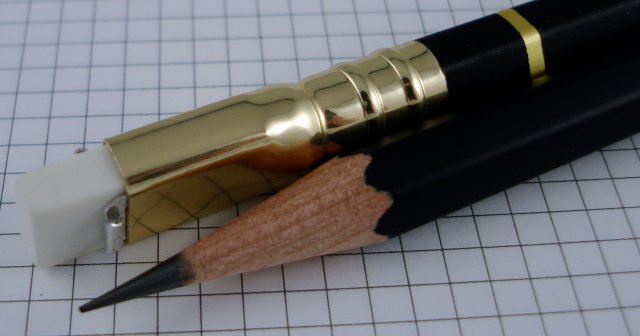
In July 2009, pencil aficionado extraordinaire Adair commented at this blog, “I wish that the visionary leader at Palomino would buy the rights to the Blackwing and come out with a contemporary version of it.”
Out of curiosity, I took a look at the US Patent and Trademark website, and saw that CalCeder had applied to register the expired Blackwing trademark. I replied: “Sanford has let the Blackwing trademark expire (it was registered by Eberhard Faber in 1934) – and CalCedar has applied for the name – though they don’t yet have the registration. There may in fact soon be a CalCedar Blackwing!”
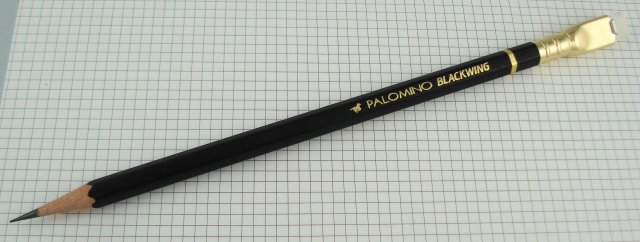
The cat was out of the bag. A subsequent email conversation with CalCedar revealed that this observation regarding the trademark was correct, and that it had become an idea in motion, with CalCedar contemplating the release of a new Blackwing!
For those not familiar with CalCedar, they are a major firm in the pencil industry infrastructure, harvesting cedar logs in California and Oregon, and processing the logs into pencil slats at their factory in Tianjin, China. They also process and sell Basswood slats.
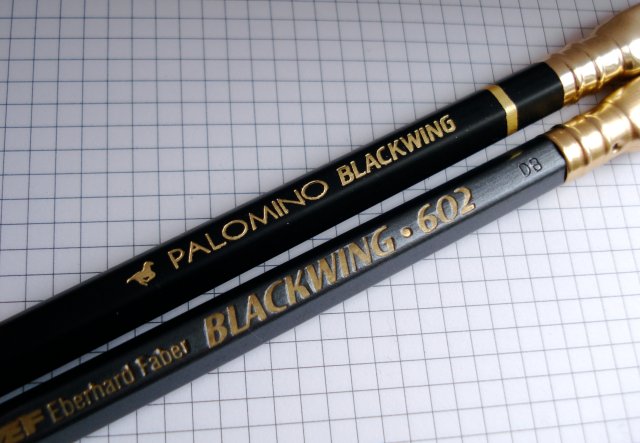
The Blackwing, if you are reading this post, may need even less introduction. Please see pencil talk‘s review, and especially, the amazing Blackwing Pages. I appreciate some recent links to the pencil talk review, particularly from Mark Frauenfelder at BoingBoing and Jenny Larew at The Blackwing Diaries. I especially appreciate Jenny’s link as her November 2005 post on the origin of her blog’s title (and I’ll note, that was the same month I started this blog) was, along with Henry Petroski’s The Pencil and a 2002 Boston Globe article, one of the major sources of fuel for the ongoing excitement over this pencil.
Fast forward to the present, and we have CalCedar announcing the release of a pre-production pencil to a limited audience, with reactions solicited.
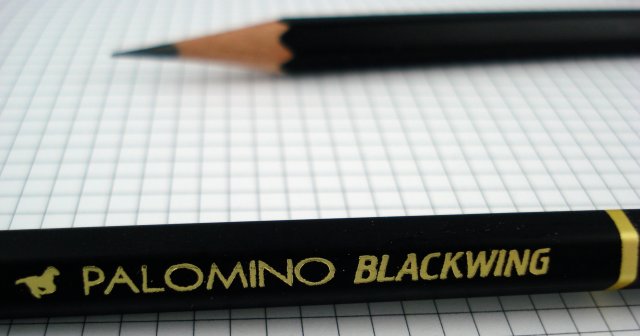
(Let me step aside from the review and say congratulations. Well done, Charles and company! Introducing a pencil in 2010 can not be easy, and we wish you well!)
There are always challenges with remakes, tributes, and reinterpretations. Did you see the recent US version of The Prisoner? Have you ever heard a bad tribute band? We hope this pencil will be a moment of triumph rather than a parody.
In many tests that I’ve participated in – alpha, beta, and undesignated – of various “hi-tech” products, the tester typically has a good idea of the product’s aims/goals/features, and possibly even support materials such as manuals, detailed specifications, and release notes regarding the object of testing.
Here, all we know is that the pencil is “pre-production”. So what does that mean? Unfortunately, not much.
My approach is to take two courses of evaluation – first, evaluate this pencil in comparison to the original, and second, to consider it as an evolved or next generation Blackwing. Both goals may have merit, though I doubt whether it would be possible to satisfactorily recreate a long defunct pencil. Equipment, wood sources, graphite core sources, paints, lacquers, glues and other materials have all changed over time. Paper as well. Further, I don’t think CalCedar has purchased any intellectual property such as formulae or machine specifications from Sanford.

I’ll also speculate, partly based on a questionnaire that accompanied the samples, that the pencil is basically finished, with only the exterior – final paint choices, packaging, and pricing – to be determined.
I’m also curious about the real magnitude of the Blackwing appeal. As regularly noted, the pencil failed in 1998. Word processing and software animation programs were already dominant then. In 2010, what will be the audience?
So on with the review!
Dimensions
While a sample original pencil weighed 5.3 grams, a new one is 6.5 grams. Hold on! This is a major surprise! This sample of one may not mean that much, as the wood in pencils can vary from specimen to specimen. Yet at about 20% heavier – I am wondering about what’s going on.
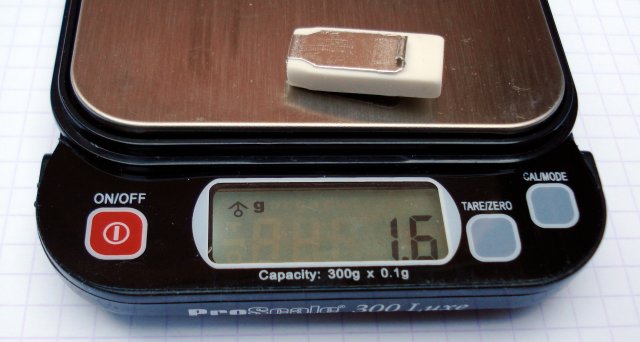
The size of the pencil is perhaps even more of a surprise – while the overall trend is for pencils to get narrower (cost savings from getting more pencils per slat), the new pencil is wider than the original! Just slightly – 7.25mm vs. 6.85mm measured side to opposite side – yet how interesting! It bodes well for the Palomino Blackwing to assume more traditional pencil proportions.
Appearance
Finish
The paint is matte black, rather like high end pencils from Pentel, Ohto, and Kita-Boshi. That is nice enough for aficionados, though I am worried that it will not succeed in the US market, accustomed to gloss finishes.
Lettering
The lettering is in gold, and simply shows the Palomino logo with the words “Palomino” and “Blackwing”. “Palomino” is in the style of the Palomino pencil, while “Blackwing” seems derived from the original. See the review at Orange Crate Art for a great discussion of the design, as well as the pencil as a whole.

There are also gold flecks all over the pencil, even on the opposite side of the pencil from the lettering.

This is the one aspect of this “pre-production” pencil that seems completely unacceptable for a product that aims to be in the top echelon. It looks like an amateur effort, and is poorly executed. Whether the aim is retro or modern, CalCedar need to engage the services of a professional graphic designer and employ the highest quality production techniques. (I’m sure some people reading this post would be capable!) Take a look at some of the designs coming from Faber-Castell or the top Japanese firms. The Blackwing needs to be in this company.
What may be equally important to some is that the original slogan, “Half the Pressure, Twice the Speed”, is absent.
Ferrule
The unique ferrule was part of the original’s essence, and is recreated in the new version. The newer version has a shinier surface, less of the bronze hue, and doesn’t show the crimp points of the original – i.e. it must be affixed by a continuous clamp process.
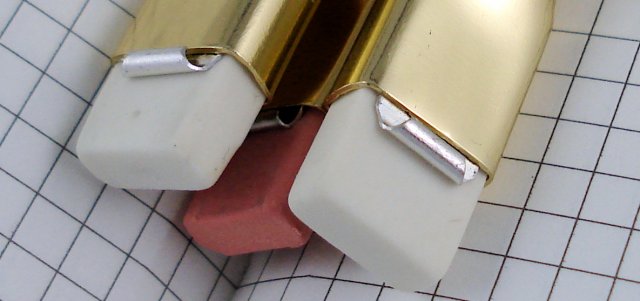
Eraser
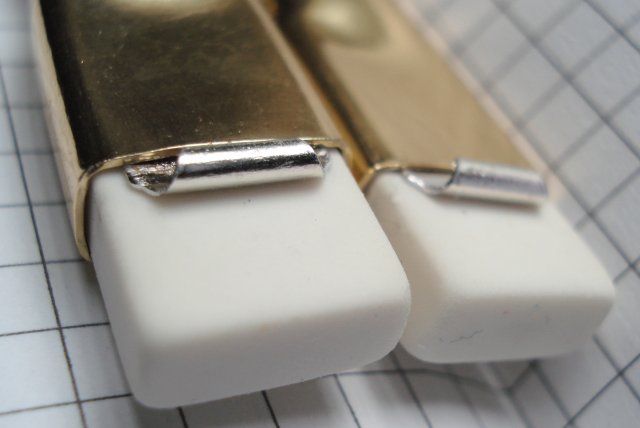
The eraser is white. Huh? Okay, this suggests that the pencil is the “Blackwing 2” rather than the “Blackwing 603”. Either could be fine, but the design needs to be clear. A modern vinyl eraser is a great idea, but the white/black/gold combination seems a bit off – how about a black eraser? I cut a trial piece to test:
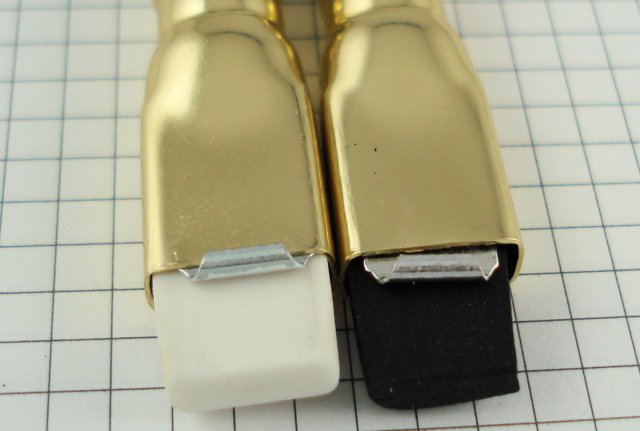
What do you think?
Writing
Darkness
The Palomino Blackwing lays down an exceptionally dark line. The challenge of pencil making is that as the graphite to clay ratio increases, the stability decreases. A 10B pencil, beautiful as the marks are, is extremely soft and decomposes quickly.
Apart from quick wear in a general sense, a specific issue with darker leads is crumbling. This is basic reason the regular Palomino isn’t considered to be as good as the top two Japanese pencils – the Palomino crumbles much more than the Hi-Uni and Mono 100.
Luminescence
Just as light bulbs emit heat as well as light, pencils emit luminescent, shiny markings apart from their dark markings.
On Strathmore 400 Series 218gsm black paper, I can’t say that I discerned any difference versus other pencils. Not that they didn’t exist, but if so, the difference was in degrees rather than magnitudes.
Smoothness
I have described the original Blackwing as beyond smooth, veering into being “slippery”. The Palomino Blackwing is less so. For me, that is fine and good. But I’m wondering if those hoping for a recreation of the original will be disappointed. It is still plenty smooth, the best in the business.
Keeping a point (wear)
Pencil aficionado Robert (of Taiwan), who has made many online contributions here and elsewhere, and who has sent me some very nice pencils including the Ohto 9000, has mentioned this aspect of pencils a few times.
Alas, an acute point does easily snap after being sharpened, and the point does rapidly wear down with use. This is a core aspect of the pencil that I doubt will change. If this is the premiere evaluation criterium for anyone, pencils from Faber-Castell, Tombow, or others may better suited.
Fastness
On a fantastic white coated paper like Clairefontaine, the Palomino Blackwing is a smear monster! Seriously, it exemplifies what some people hate about pencils in a way I’ve rarely witnesed. The marks become like finger paint. I don’t know why, but presumably something in the formula repels something in the Clairefontaine paper’s coating.
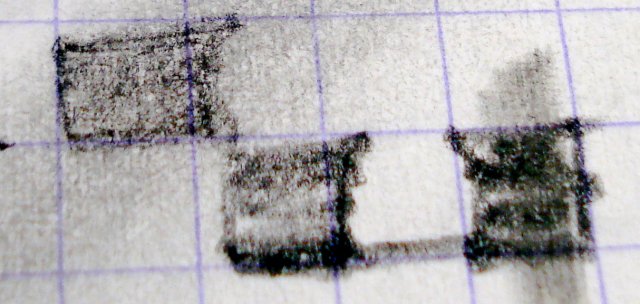
That is too bad, as I love using the great products from Clairefontaine and Rhodia with pencil. This result won’t stop me, but I’ll be more cautious.
On more fibrous paper. there is again some smearning, but at a more acceptable level.
Tests on Paper
I’ve tried the Blackwing on newsprint, office copy paper, and on looseleaf Clairefontaine paper, and cream coloured papers in typical Moleskine, Leuchtturm, Canteo, etc. journals.
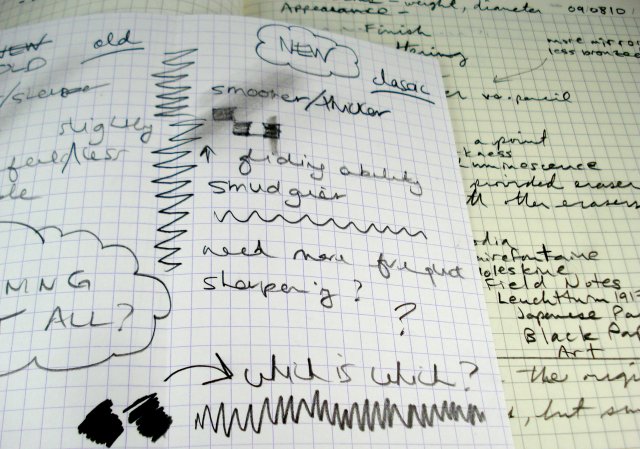
Crossword puzzle devotees may enjoy the dark lines of the Blackwing. Office copy paper is tuned for the high speed laser printer, but does well.
On the thicker cream coloured journal papers (Canteo in particular), the line was superb. It was also excellent on other such papers. As noted, coated papers produced more smearing, though the pencil lines still looked excellent. And looseleaf Clairefontaine paper fared a bit better than Clairefontaine journals for reasons unknown.
Basically, the Blackwing works with everything, and especially excels with thicker cream coloured paper.
Writing (Overall)
The Palomino Blackwing is excellent for cursive writing and note taking on many paper types. It is not the best for small mathematical notations or any task requiring a sharp point.
Other considerations
Aroma
Probably due to being fresh out of a factory, the pencils have a strong paint or chemical aroma. I’ll assume production pencils won’t have this issue.
Sharpening
Cedar typically sharpens well, and the Blackwing Palomino was no exception. CalCedar sent only two pencils, so the testing possibilities are limited here.
Erasability
Another downside to dark rich lines is that they are harder to erase. There is no exception here. The pencil’s own eraser, and other erasers such as the top tier Pilot Foam only do a so-so job on the Blackwing’s lines.
I’d like to thank CalCedar for the pencil samples.
I said there were two courses of evaluation for this product. After using the prototype, I see the Palomino Blackwing as being too different from the original Eberhard Faber Blackwing 602 in appearance and graphite function to be considered a clone or reissue. Rather, it is a modern interpretation – and a very fine one indeed.
[Update: September 15, 2010]
I feel uncomfortable about having inadvertently misled the readers of this blog about just what was being reviewed in this post.
A statement from CalCedar confirms that these are not “pre-production” pencils at all – they are in every sense “production” pencils that will soon be for sale. As well, we are told that the questionnaire that accompanied the pencils will be used to inform a possible second version of the pencil.
It all makes no sense to me – I believe the same level of enthusiasm would have been shown, and the same amount of publicity garnered if CalCedar had just given reviewers the facts. While I’d like to believe that there was no intent to mislead, it seems absolutely implausible that these coordinated actions were all accidental or mistakes. The situation is so simple that it astounds me that trickery like this was felt necessary.

I was eager to read your impressions, which is why I wasn’t very forthcoming at first about how the Palomino Blacking might diverge from the original. As per usual, wonderful pictures and excellent writing. Now that you’ve got your initial impressions down, things seem very much “official” now :)
all the best,
Sean
Great overview, thanks! I’ve got a few comments I’d like to make but I’m on my way out the door so I’ll have to get to them later.
P.S. I’ll tell Michael about the point strength thing since he was so curious. :D
Thanks for a very thorough, beautifully written, and thoughtful review. I agree with the majority of your points, especially for the need to improve graphic design. I do differ on the issue of smoothness: I find the lead in my two sample Palomino Blackwings to be smoother than the 1990’s Blackwings and about equal to those of the 1930’s, to which Sean introduced me. Sean’s incredible Blackwing Pages (which I sorely miss)showed the marked differences among various generations of the Blackwing—to what specific incarnations of the Blackwing are we comparing the Palomino version? I also find the Palomino version darker than all the previous generations of Blackwings. Let’s see when this pencil will be released, and if the suggested improvements that most of us have suggested will be implemented. I find it a remarkable pencil, even as is. Thanks again for a great review!
Great review and photographs, Stephen. There seems to be some strong consensus about the need to improve the pencil’s appearance.
Thank you for that excellent review and the outstanding photos – I am flabbergasted!
This is the most thorough review I’ve seen yet on the new Blackwing. Many thanks.
An excellent review – I bow to your thoroughness and wisdom.
Ugh! “Suggested improvements that most of us have suggested”–please forgive this careless blunder, especially in response to such a well-written review! I should never type past my bedtime.
Great review! sounds like a promising pencil. It does look better with a black eraser hopefully with the performance of a Uni-ball Boxy eraser.
What can I say, that haven’t been said already? but thanks for a very thorough, beautifully photographed and in every way excellent review.
Now we just need a release date :-)
regards Henrik
Ps. Sean, I miss your blog!
This review is especially great, and the standard on this site is pretty high to begin with. : )
I had some bad experiences with the new Blackwing and Moleskine paper, but, as you say, thicker paper is very fine with this soft lead. I was a little put off by the white eraser, but I’ve kind of gotten used to it.
At the risk of being overly-self-promoting, we finally got the Blackwing review up on Pencil Revolution, which is back!
http://www.pencilrevolution.com/2010/09/new-blackwing-pre-review/
I hope they release these into the mainstream market! I was just 4 years old when they discontinued the Blackwing 602, and since I got into pencils, wished I could have gotten one back then. Too bad they’re about 20-40 dollars apiece now…
But that’s why I want the new one…the reincarnation of the best pencil in the world!
Thank you very much for this thorough review.
I’m glad you tried to cut a black eraser to show what it looks like…I made that exact suggestion back on Sean’s blog, and I think the result would be much more attractive than the default white, and even a bit nicer than the classic pink.
Seems the more I read about the new Blackwing though, the less interested I become. From other posts and your review on the original Blackwing, I was under the impression that smear resistance was one of the pencil’s strengths. I would have been extremely attracted to the prospect of a very smooth lead that didn’t smudge much, even if the line darkness was not extreme, and especially if the point wasn’t horribly fragile. Instead, it just seems like they are making am extra dark and soft Palomino lead. If that’s the case, I don’t see what, other than a novel eraser and a thinner lead core, the new Blackwing could offer me that I don’t get in a 4B (or 6B) Uni Penmanship pencil, or any other ultra-soft pencil for that matter.
Perhaps my impression of the Blackwing, from the reviews here and elsewhere, were a bit off, and led me to hope that the new one would maintain the same general qualities that I projected onto the original, and that would have made it quite different from other soft-grade pencils. I’ll still probably get a few when they are finally released, but it seems like they are not really a product for a writer like me.
Thanks again for the review!
Robert: wait until you have one in your hand and write with it. There is a smoothness to this pencil that is uncanny and superior to other soft-grade pencils, to Japanese pencils, and even to the older Blackwings. It isn’t merely a darker Palomino. You will write with great speed, as if there were no resistance at all. And it is the darkest lead I’ve experienced that does not blur or thicken the letters. It is wonderful to get such clear, black articulation from a pencil. I’ll be very interested to see your reactions once you have the actual pencil in hand—which I hope will be soon.
All, thank you for the comments. I am glad the review was well received.
Adair, I should have stated which Blackwing was used for the comparison. It was a 1990s version, shown in the photos.
John, congratulations on the relaunch of your blog!
Thanks, S! It’s good to be back, after a very long time. You’ve been publishing continuously for a heck of a long time, especially in blog years. Congrats on your up-coming anniversary! : )
As usual from Pencil Talk a detailed and thorough analysis. As I acknowledge today in my latest post “Reviving the Blackwing: Understanding the Traditional Blackwing Fan” your assessment is accurate with respect to our pencil not being a clone of the original Blackwing. This pencil never was intended to be an exact copy, but to revive the spirit of the original. I certainly understand if you do not feel that has yet been accomplished and do appreciate the positive feedback wyou also provide along with your overall assessments. Frankly I’ve been rather surprised at the degree to which Blackwing fans long for and expected an exact copy down to the minutest detail. Nevertheless, I have found all this a very valuable process. As we move towards making these initial production pencils available for sale in the next few weeks I’ll explain my rationale for design decisions made to this point. I’ll also address recommended changes going forward for future production within various constraints we are dealing with as we move on.
http://timberlines.blogspot.com/2010/09/reviving-blackwing-understanding.html
Finally, one last note of correction on your post. The author of “The Pencil” is Henry Petroski, not Charles Petroski. Perhaps a minor detail, but wanted to make sure proper credit was given for that fine work of pencil industry history.
I think I’m not actually as huge a fan of the Blackwing as many others. Yet in any established commercial realm, if a new product takes an older product’s name and look, and the sponsor goes so far as to register an expired trademark of the predecessor product, these acts all invite comparison, don’t they?
And … corrected. That’s embarrassing, and interesting that no one else caught it. You can guess whose name was on my mind!
I’ve never used a Blackwing.
One of the reasons I like writing with a pencil instead of a pen is that bit of friction between lead and paper.
Ballpoints and rollerballs and even fountain pens run away with my writing reducing it a wiggly line at speed.
Pencils slow me down just enough to keep the writing legible.
So if the Blackwing is that smooth it’s probably not the pencil for me.
The smudginess bothers me in a writing pencil, too. I smudge drawings but I want writng to stay clear.
I applaud the vinyl eraser choice. I had a bunch of original Blackwings, but sold them. The pencils wrote great, but oh, those erasers–horrible, even new out of the box. As hard as concrete.
Apt review! I hear what you say about the nice, creamy paper allowing the graphite to smudge. I love writing in my Rhodia notepads with a pencil, but as a left-hander, I oftensmudge my markings beyond all recognition with the side of my hand.
In any case, I will love to see what CalCedar comes up with. While I, too, would love a perfect replica, I’m not particularly expecting that. I think I can settle for some kind of hybrid between the Blackwing and the Palomino, which are, after all, the two finest pencils I’ve used.
Thank you for the wonderfully detailed photography and descriptive writing.
This is huge, for lack of a better expression. I have been dying to try a Blackwing for several years! I’ve no experience with the original, but I’ve heard so much about them.
CalCedar is rapidly becoming my favorite U.S. pencil supplier, since Musgrave seems focused on making logo’d school pencils these days.
CalCedar definitely keeps one ear to the ground and a finger on the pulse of the industry!
I love that the Palomino Blackwing is a little different. The other iterations of the Blackwing vary slightly, so why not this one? Cloning is not exactly possible even in DNA science. I have had the chance to test this one out due to a friend’s generosity… To each her own pencil…I happen to like the creamy lead and feel of the lacquer and the weight of this new Blackwing.
Thanks for this very detailed review. I’m looking forward to giving a few of these a test drive on my own. Nice pics too!
Lisa, I agree: the lead couldn’t be smoother, at least, I’ve never encountered one smoother, not even the original Blackwings, which is saying a lot. Balance and weight are just perfect, too. Lacquer, I think could have been better, but at this point, I just want the darn thing to go on sale!
Already purchased a set, based in no small part on this review. Thanks much.
Despite my better judgment, I too ordered a single box and will give them an honest try when they eventually arrive. Even if I like the lead and ferrule, I probably will not be buying any more, unless I want to undertake the not-so-insignificant project of stripping and re-lacquering them.
Perhaps if their sales are strong enough, they’ll be able to come out with a better version in the future, even if it’s just a limited edition. Seems unlikely though, judging by how they’ve apparently categorized their feedback as “loves it as-is” and “Blackwing traditionalist”.
Such is life, I guess. It would take a lot to really botch a Blackwing release, once the company manages to get the ferrule and name. They could slap the ferrule on a Ticonderoga Noir or an old Yikes! pencil and still have a relative success. CalCedar might have shown some incompetence in a few areas, but certainly not enough to sink the Blackwing ship, at least in the short term.
Martha, glad you liked the review.
Robert, that sounds fair and thoughtful. I hope you will share your findings after you receive the pencils.
Robert, whatever the shortcomings of the Palomino Blackwing, I assure you it is better than a Ticonderoga Noir…(And I am one of the few who thinks that the contemporary Ticonderoga is an ok daily user…)Once you try that buttery-soft lead of the new Blackwing, you’ll see for yourself. As far as lead is concerned, it is the best pencil available today. And having tried several vintage Blackwings, I can say that it is superior to the original Blackwing in terms of lead smoothness, even if certain improvements might still be made on lacquer and typography—I think that these will come with time. For now, if you want a superb writing tool, you can rely on the Palomino Blackwing. Give it a chance. I guarantee that you won’t be disappointed.
I just got mine!
I love them! I have never used an actual Blackwing 602 so I have no point of comparison. They feel like the love child of Mitsubishi Hi-Unis and Palominos. I find the Mitsubishis to be a bit waxy (I prefer the slight crumbliness of the Palomino and it’s little brother Golden Bear), but the Palomino Blackwings manage to be smooth without the waxiness.
I received mine today. Simply awesome. I will hand sharpen them with a small pen blade and just remove wood and not the pencil lead. When the pencil gets to short to hold, I’ll cut off the ferrule, split the wood and place into an artist lead holder.
It also appears to work well in my Moleskines.
Apart from the pencil properties, it seems the Blackwing shipping system works very well. Ordering on a Friday and receiving the product on Monday is hard to top!
Hmmm…I ordered mine early on Friday and I still have not received them! What gives?
I have some extraordinary gilt painted pencils from the early 1900s which are a work of art. Too old and perfect to use. Nothing can match them especially considering their age; just to look at. The new Blackwing may have some microscopic flaws in it’s finish but I could care less. It’s the writing that matters most and it excels, including in my Moleskine. One will be added to my edc art pencils.
The company just launched a slideshow “video” on YouTube to showcase some of the stuff done with the Palomino Blackwing. It’s almost embarrassingly bad. It’s so bad that I’m amazed any of the artists being showcased would be willing to have their work thus presented. I would be downright offended if it were my work. CalCedar would REALLY benefit from some competent creative work. Hell, I’m sure some of us would take pity on them enough to offer some work for next to nothing (I wonder if Sean is getting compensated for his photos).
Heh, re-reading my own comment made it sound much more negative than I initially intended. I mean to say that Mr. Berolzheimer is not doing the artists and other users justice by showcasing their work in a way reminiscent of an early-1990s kindergarten class, and this kind of project would best be delegated to someone with at least a modest amount of technical and creative competence. I am guessing they have no creative budget for pet projects, which is why I suggested that there are likely some folks around who are willing to lend a hand.
When the pencil gets to short to hold, I’ll cut off the ferrule, split the wood and place into an artist lead holder.
How does one best do this without breaking things or slicing one’s own fingers off? Because it certainly has the potential to massively expand the availability of lead for my Staedtler 780.
To cut off the ferrule, roll a 1″ pen knife back and forth. It will create a small cut around the pencil then snap off the ferrel. Take the pen knife and split the wood along the side. Most of the lead will be expsosed. Carefully whittle off the remaining wood. It might take a whole 5 minutes. Use a sharp pen knife not a dull one which can slip which causes an accident. This is really basic pocket knife handling skills.
I don’t like craft knives.
Received mine…
It is a fine pencil. It writes well enough to be comparable to the original Blackwing.
However, there are far too many comparable alternatives that do not cost twenty dollars to make it worthwhile.
For the money, it should possess better aesthetics, ship with better packaging and simply act the part.
This is made/finished in Japan and comes in a common black paperboard box. This, from the same country that produces Tombow and Mitsubishi products in lovely plastic durable containers.
-Just too expensive.
Received mine, too, and I disagree with you about their value. Those Mitsubishi and Tombow pencils cost more and don’t have erasers, much less the really cool eraser of the Blackwing, and who needs more plastic boxes you have to throw away? I don’t even think I would have noticed the gold flecks in the finish—a flaw Woodchuck says will be remedied—if I hadn’t read about them here. It’s an outstanding pencil, and there are certainly too few of those around.
Throw them away??? Hmmm. -Never thought of doing that.
As far as the eraser is concerned, I’ll never use it. I never have a need to erase anything at all and this is due to the fact that I spend my pencils drawing, not writing. (but I do know writers that don’t erase as well, they just strike thru)
I received my supply yesterday and I must say that I am pleased. Yes, the gold flecks on the barrel will need to be remedied—Woodchuck is aware of this—and the stamping of the pencil name on the barrel needs to be cleaner, sharper, up to the standards of the Palomino and other Cal Cedar lines. But when it comes to writing performance, well, this is as good as it gets in terms of darkness and smoothness, at least in my experience. I rank these pencils higher even than the Tombow and Mitsubishi, which is saying a great deal. As for price, these pencils average at $1.60 each, much cheaper than the Hi-Uni, not to mention than the original Blackwings at $30 and $40 a pop. Even the (to me) inferior Rhodia pencils are usually $2.oo apiece. Frankly, I had expected the Palomino Blackwing to be more expensive, and I am grateful that it is so reasonably priced. Oh, and I LOVE the black boxes with the gold labels. They are elegant!
I just sharpened my first Blackwing this morning, and once I got a point it wrote well. The only trouble was the point broke in the long point sharpener, and I tired two other sharpeners and had the same results. Finally on my fourth sharpener I was able to get a point, but I’ve lost about 1/3rd of the pencil. I’m sure that this is an isolated problem, because I have never had a problem sharpening any of the Cal Cedar brands.
Eric, I’ve given up on most sharpeners except for the Carl Decade. This amazing sharpener, available from Bundoki, will give you a perfect point every time. I wouldn’t touch my new Palomino Blackwings or other quality pencils with any other sharpener. Don’t laugh, but I carry one with me in my bag.
The Carl Decade DE-100 and Bungu Ryodo BR-05 sharpeners are my favourites as well (I thing they share the same mechanism) and I use only these. Don’t laugh at me either, but I have three of them at various places (including the office) and a spare one.
No laughs from me. I have several at work, and at home. I will have to look into your suggestions. Thanks
I don’t think I’ll even be trying these. :( I emailed the company asking if I could try a sample and they said no. Once the pencils became available for sale, I was disappointed to see that you have to purchase a dozen for twenty bucks plus shipping if you want to just try it. I then emailed them again, asking if I could buy just one pencil to try. They said no. They couldn’t sell them in smaller quantities. I thought that was very poor customer service. So now, I’m going to just save up my money and keep buying the real ones on eBay. I also plan to throw out or give away my Palomino pencils and will not buy from them in the future.
Received my box yesterday, and I’m very pleased with the feel and “tooth” of the glide.
Considering the finish and detail of the Palomino Orange 2B, the Blackwing finish does need work.
I would prefer a glossy finish, and no specks as others have said…and crisper markings.